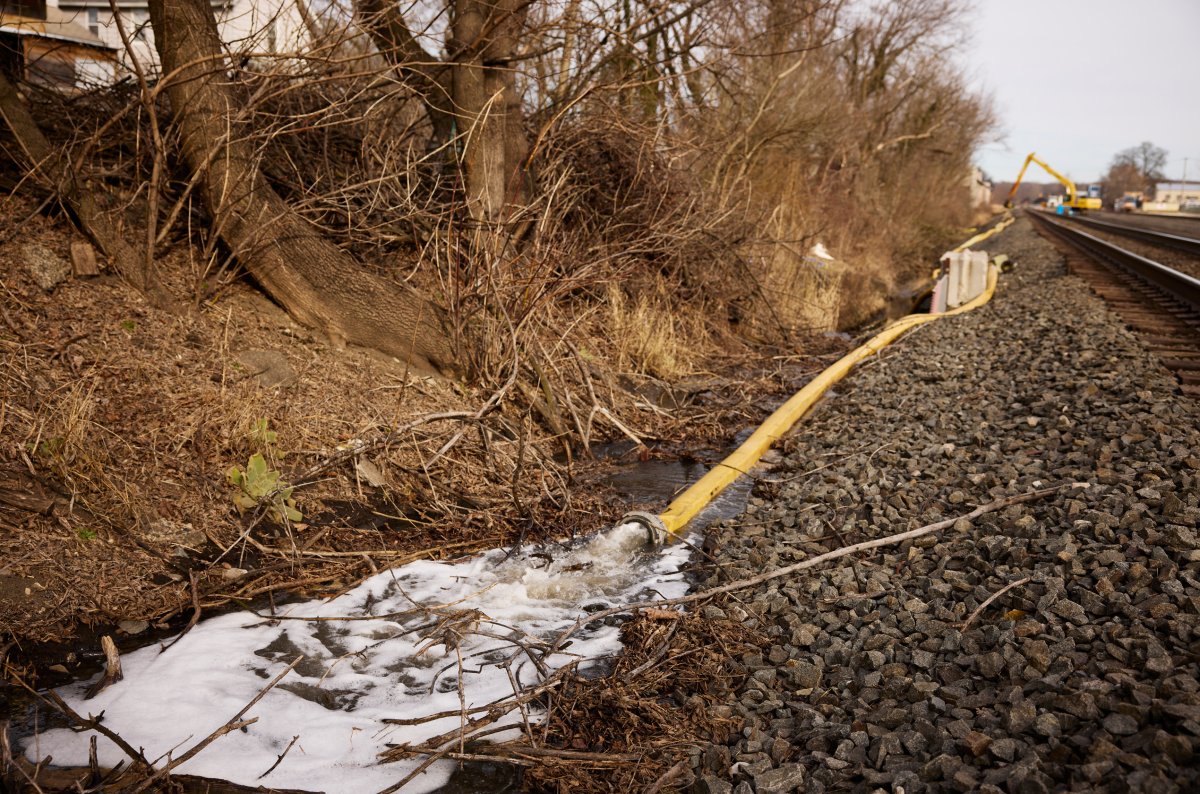The toxic mixture of chemicals and carcinogens released from the wreckage of the Norfolk Southern Railway train derailment in Ohio on February 3 could spread many miles out from the crash site, experts say.
The chemicals—including vinyl chloride, butyl acrylate, ethylhexyl acrylate and ethylene glycol monobutyl, according to the Environmental Protection Agency (EPA)— were being carried aboard the train when it derailed. Due to the volatile and explosive nature of many of the compounds, authorities conducted a controlled burn of the chemicals to prevent an explosion.
The fire sent up a large plume of black smoke. When burned, vinyl chloride reacts to form phosphene gas, which was used as a chemical weapon in World War I.

While the overall ecological impact of the chemical spill is not yet known, the effects of these chemicals could continually spread for several miles through the air around the town, depending on the concentration of the released chemicals and local conditions.
"It depends very much on the weather conditions, particularly wind speed and direction and on the quantities—but potentially well over 100 miles radius," Veronica Edmonds-Brown, an expert in urban river pollution and lecturer in aquatic ecology at the University of Hertfordshire in the U.K., told Newsweek.
One report on a similar vinyl chloride release in 2012 in Paulsboro, New Jersey, estimates that vinyl chloride levels in the air near the release point reached thousands of parts per million in the first hour after the derailment but levels dropped to 250 parts per million at a distance of 0.8 miles away.
"The important factors are the levels in the air and the duration of the exposure," A. Daniel Jones, a professor of biochemistry at Michigan State University, told Newsweek. "For example, the OSHA permissible exposure to vinyl chloride is 5 ppm for up to 15 minutes, or 0.5 ppm averaged over an 8-hour work day. Based on these values, one might envision that occupationally-unacceptable levels might extend several miles from the point of release."
In the days since the derailment, a number of the toxic chemicals have been detected in nearby waterways. Subsequently, dead fish have been found in streams, pets and livestock have passed away, and residents have reported symptoms including burning eyes and breathing difficulties.
"It's well-known chemicals can move through atmospheres," Andrew J. Whelton, a professor of civil, environmental, and ecological engineering at Purdue University, told Newsweek. "There are particulate materials as well as vapors that would be transported. The black smoke from combustion indicated chemicals and particulate material being released."
The distance covered by the hazardous chemicals will depend heavily on the weather conditions, as well as the topography of the local landscape.

"Pollutants [will be] dispersed by the plume from the fire. It's not just a matter of where the winds blew and how fast, but also what happens to the chemicals as they are burned, and further chemical reactions with substances in the atmosphere. So what you measure at some distance from the train derailment would need to consider the above," Molly Jacobs, an expert in chronic disease risks from environmental exposures at the University of Massachusetts-Lowell, told Newsweek.
Residents were evacuated just after the derailment, but were allowed back to their homes on February 8 once air levels were considered safe, with Ohio Governor Mike DeWine describing air quality readings as "basically similar to what they would have expected prior to the train wreck."
The chemicals produced in the burn will also have entered the local waterways and the soil, which will cause additional ecological problems.
Environmental officials detected some contamination in the creek about one mile downstream of the derailment one day after the spill, according to their publicly available data. Kirk Kollar, an Ohio EPA representative, said the levels of toxic chemicals in nearby rivers, including the Sulphur Run, "were immediately toxic to fish."
These chemicals may be spread further away from the town via the waterways.
It’s shocking that the massive ecological & public health disaster in East Palestine OH isn’t the lead story on every network.
— Nick Mark MD (@nickmmark) February 13, 2023
Years ago I saw a man with angiosarcoma from vinyl chloride. It was unforgettable.
The long term harms of exposing thousands to this will be terrible. pic.twitter.com/hOIi4nQloM
"This will be a matter of the solubility of the chemicals in water, how fast they degrade (or not), where the water flows, and if sediments play a role in continued/future releases," Jacobs said.
Residents are being urged to have their water tested for possible traces of these chemicals and to drink bottled water only until it is confirmed safe. Ohio Department of Health Director Bruce T. Vanderhoff told a press conference on Tuesday that many residents in the East Palestine area are under "municipal water," allowing for officials to use reserves of the "most distant" wells from the derailment site.
"EPA Region 5 is also working closely with Ohio EPA to determine what impact the spill has had on surface and groundwater," a U.S. EPA representative told Newsweek. "State and local agencies are conducting sampling throughout the Ohio River to ensure drinking water intakes aren't affected, and EPA is continuing to assist the state with sampling efforts at water treatment intake points along the Ohio River."
The soil will also be contaminated by the chemicals, but will likely be affected in a much smaller radius.
"The highest loading of contamination in the soil will be closest to the derailment where spillage occurred and particulate material likely settled," Whelton said. "The farther away from the spill site, the less amount of chemicals should be found."
Norfolk Southern, the company that operates the derailed train, has said it is committed to cleaning up the chemical leak. In a press release, it also announced a $1 million charitable fund for the East Palestine community to support the costs of the evacuation.
"The cleanup involves a number of things. Right now, Norfolk Southern and its contractors are completing soil sampling, removing topsoil, and placing it in a staging area for testing and disposal, and our hazmat teams continue to transfer product from the tank cars out of the area," a Norfolk Southern representative told Newsweek.
Is there a health issue that's worrying you? Do you have a question about toxic chemicals? Let us know via health@newsweek.com. We can ask experts for advice, and your story could be featured on Newsweek.
Uncommon Knowledge
Newsweek is committed to challenging conventional wisdom and finding connections in the search for common ground.
Newsweek is committed to challenging conventional wisdom and finding connections in the search for common ground.
About the writer
Jess Thomson is a Newsweek Science Reporter based in London UK. Her focus is reporting on science, technology and healthcare. ... Read more
To read how Newsweek uses AI as a newsroom tool, Click here.






